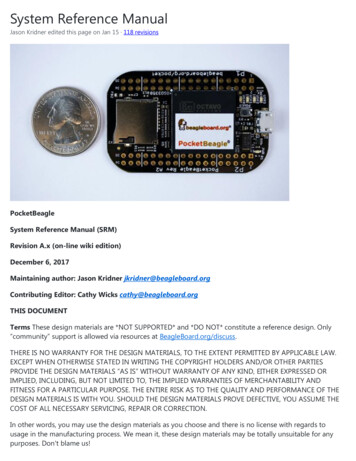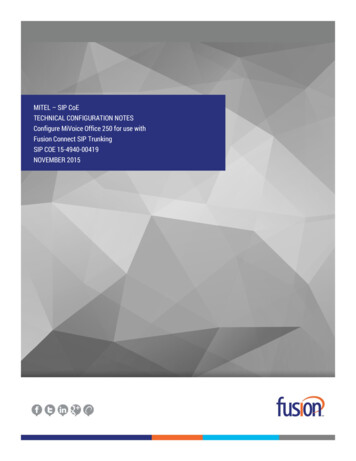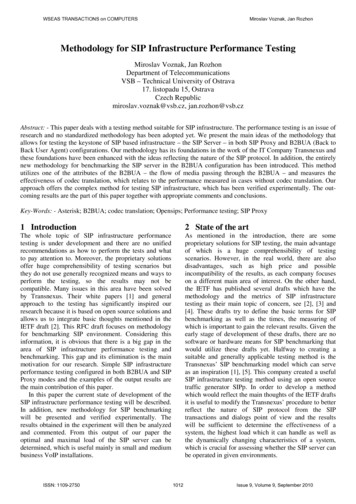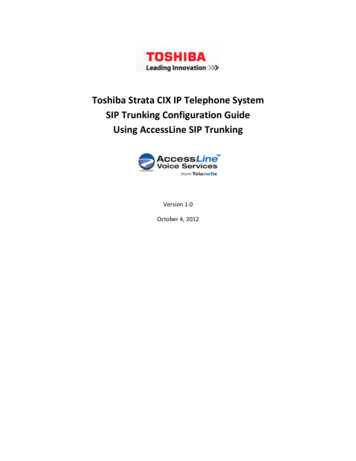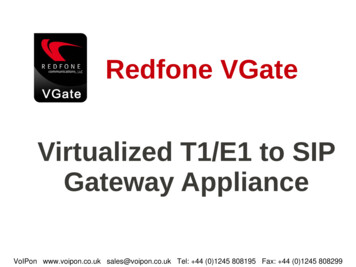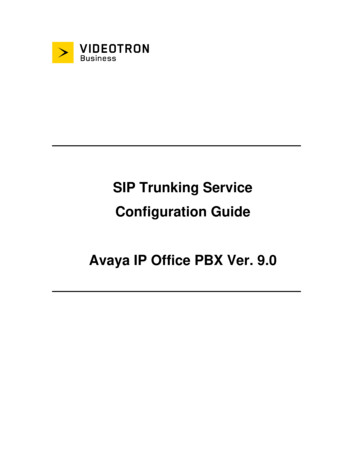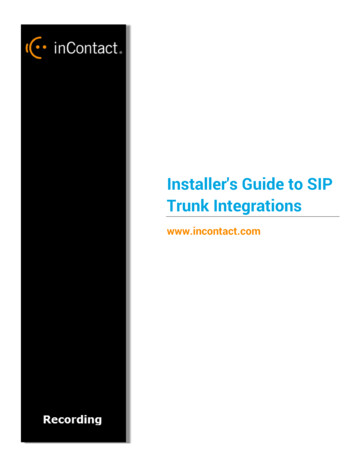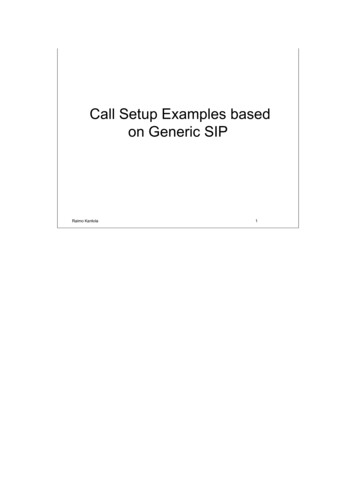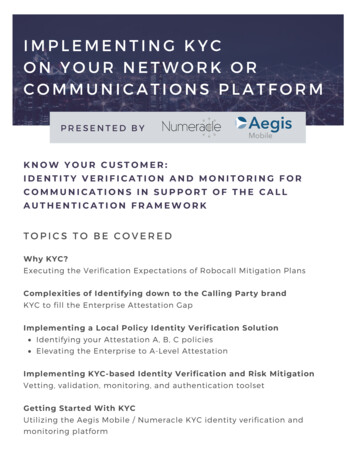
Transcription
IMPLEMENTING KYCON YOUR NETWORK ORCOMMUNICATIONS PLATFORMPRESENTED BYKNOW YOUR CUSTOMER:IDENTITY VERIFICATION AND MONITORING FORCOMMUNICATIONS IN SUPPORT OF THE CALLAUTHENTICATION FRAMEWORKTOPICS TO BE COVEREDWhy KYC?Executing the Verification Expectations of Robocall Mitigation PlansComplexities of Identifying down to the Calling Party brandKYC to fill the Enterprise Attestation GapImplementing a Local Policy Identity Verification SolutionIdentifying your Attestation A, B, C policiesElevating the Enterprise to A-Level AttestationImplementing KYC-based Identity Verification and Risk MitigationVetting, validation, monitoring, and authentication toolsetGetting Started With KYCUtilizing the Aegis Mobile / Numeracle KYC identity verification andmonitoring platform
Why KYC?Necessities for a “Know Your Customer” Framework toEstablish Verified Communications IdentityKYC didn’t use to be associated with the telecommunications industry, butas service providers execute their Robocall Mitigation Plans and continue toextend STIR/SHAKEN deployment in support of the FCC, identifying everyentity originating traffic on your network or platform with confidence is thenew normal and expectation."What that means is when a call is beingmade, a carrier can tell that it really is theperson who they say they are on the line."Acting FCC Chairwoman Rosenworcel on the criticalnature of implementing the caller ID authenticationframework.Jessica RosenworcelBoth the FCC and FTC, in particular, have been very vocal about theseemerging requirements. Over and over they have maintained it’s thecarriers’ and service providers’ responsibility to monitor and ensure noillegal traffic is being facilitated across their networks or technologyplatforms. Three waves of cease and desist letters* have been sent to voiceservice providers, or “VSPs,” found to be facilitating bad actor traffic, andthey will not be the last.Identifying every entity communicating across your network can often beeasier said than done. Today, there is a complicated relationship betweenthe entity behind the call (also referred to as the calling party, brand, orenterprise), its outsourced contact center partners, number provisioners,and any other party involved in facilitating the call’s origination.*Cease and Desist -illegalrobocall-campaigns
In order to achieve a trusted level of oversight into each party touching thecall, down to the calling party (brand, enterprise) itself, is to develop a KYCprocess to vet and validate the brand’s identity and its authorized use ofphone numbers.This goes many layers beyond understanding the service providers’ directclients — the ones they maintain an actual contractual relationship with.This spans the depths of VSPs also needing to understand their clients’clients (and those clients’ clients, and so forth) as well as any intermediarywho the service provider is directly or indirectly delivering or facilitatingcalls on or on behalf of, from the calls’ origination to the calls’ termination.KYC fulfills service provider requirements asdefined by the FCC:The need to vet and validate the identity of entitiesusing the networkAuthentication of brand identity authorization touse phone numbersImplementing a local policy to identify and monitorfor bad actor traffic
Complexities of Identifying down to theCalling Party brandSTIR/SHAKEN Framework: C-Level AttestationA very common and complex situation faced by many originating serviceproviders is the role of the intermediary in delivering traffic on behalf of anenterprise brand. In this situation, a Voice Service Provider (VSP) isoriginating calls that are facilitated through a Business Process Outsourcer(BPO) or external contact center on behalf of its enterprise clients.In this case, the VSP has a direct contractual relationship with the externalcontact center, but not the enterprise brand itself. To further complicatethings, the VSP also doesn’t have direct visibility into the source of phonenumbers procured for use by the enterprise brand. It’s perfectly plausiblethat the VSP has no idea who the enterprise brand actually is. Therefore,how could this VSP be able to attest to the identity of the caller and itsauthorized use of the phone numbers it intends to display? Figure 4. Attestation Level C for Enterprise
Complexities of Identifying down to theCalling Party brandSTIR/SHAKEN Framework: C-Level AttestationThis situation results in the terminating service provider’s receipt of a CLevel STIR/SHAKEN attested call, an enterprise brand who is probablyunhappy with the inability to achieve A-Level attestation, and an originatingservice provider who’s looking for a solution to be able to verify, withconfidence, down to the brand identity.There is still value in C-Level attestation as it relates to traceback efforts, butthe value to both the caller and the callee is diminished as the call will notbe delivered with A-Level-defined verified number indicators (such as acheckmark, etc.).Implementing a Local Policy Identity VerificationSolutionIdentifying your Attestation A, B, C policiesFor originating service providers, your “local policy” otherwise known as“how you define how to meet the requirements of signing to A, B or C levelbased on the STIR/SHAKEN standards” starts with the question of “howdeep do you want to vet?” Is a signed contract in hand good enough tostand up to the robust expectations of the FCC, or does it need to godeeper?As explored in the section prior, “Complexities of Identifying down to theCalling Party brand,” what if your direct (contractual) customer is not thecalling party? Can you trust your direct customers’ processes to vet theircustomers one level down, or is that additional level of KYC vetting andvalidation required based on how you define your local policy?Based on the Standards, it’s expected when an originating provider signs acall at A Level, that provider knows who the actual calling party is using thatphone number; this requires a KYC process that must extend all the waydown to the caller identity of the brand or entity represented within thebody of the call.
As a VSP, you need the confidence to trust the users of your platform all theway down to the brand level. Any resistance you see from customers onyour platform who don’t want to meet the requirements of your local policyand demand to remain anonymous might just be the bad actors you don’twant to unknowingly facilitate a la Globex or Alcazar.Elevating the Enterprise to A-Level AttestationThe industry has done a pretty good job at1 spreading 2the word about ALevel Attestation, so much so that enterprise brands are asking for itdirectly without even truly grasping what it means from a technologyperspective.So when it comes to your customers asking you for A Level Attestation, youneed to do your part to know whom the calling party brand representedwithin the call is, regardless of whether or not they procured numbers fromyou or are directly contracted with you.To elevate enterprises you’re currently attesting at B or C-Level to A-Level, aKYC process has to be implemented to authenticate each intermediaryalong the call chain down to the calling party brand in order to fulfill thedue diligence requirements as set forth by the FCC.Outbound calling structure involving multiple entities in the call scenariomakes achieving a STIR/SHAKEN A-Level attestation for an enterprise brandthat outsources calling operations to communications vendors (even the100% legal, compliant, and trustworthy vendors) extremely cumbersomeand difficult. That is Aegis Mobile and Numeraclehave teamed up to make the process a whole lot lesscomplicated.Implementation of a KYC-based local policysolution supports service and platformprovider’s ability to assess the level ofattestation achievable based on theavailability of information to vet and verifydown to the enterprise or calling partybrand, with confidence.
Implementing KYC-based Identity Verification and RiskMitigationA comprehensive vetting, validation, monitoring, andauthentication tool setAegis Mobile and Numeracle have joined together to support the ongoingservice provider requirements of STIR/SHAKEN execution and theassociated Robocall Mitigation Plans required to continue to strengthenand ensure the success of the caller authentication framework deployed.The implementation of a KYC process in communications is all aboutbringing identity into the voice network so the consumer being calledknows the entity calling them has been verified. The Aegis NumeracleKYC-based identity verification and risk mitigation solution allows theservice provider to use company information collected to unambiguouslyidentify via research of the business entity to determine trust level andcorresponding service level in order to support these verificationrequirements, regardless of a direct relationship to the calling party brand,or not.This solution was designed for:Service Providers fulfilling Robocall Mitigation Plansurveillance, risk monitoring, and fraud detectionrequirementsService Providers elevating enterprise calls from C or BLevel attestation to A-LevelThe need to implement multi-tiered levels of entityidentification to cover the various intermediarytouchpoints a call passes through (vendors, contact centers,etc.), all the way down to the brand levelAvoiding the mistakes of other VSPs found to be facilitatingillegal calling activity due to lack of KYC process in place
Whatever your local policy determines as the fulfillment of the verificationrequirements outlined by the FCC or in reaction to FTC orders against VSPsfound to be facilitating illegal activity, we can help you meet thoseverification checkpoints. However you'd like to define your KYC process,completion of identity vetting and phone number authorization,implementation of double-authenticated touchpoints, collection ofdocumentation to explain the needs of the call down to the brand level, etc.,Numeracle and Aegis are here to provide a flexible, fully-auditable solutionto meet your needs.Getting Started with KYCUtilizing the Aegis Mobile / Numeracle KYC identityverification and monitoring platformTo begin the process of instituting a KYC-based entity vetting processwithin your organization today, contact us at www.numeracle.com/contactand mention Aegis or connect directly with Aegis athttps://aegismobile.com/contact/ and mention Numeracle.Numeracle’sEntityIdentityManagement PlatformandVerified Identity platform enablelegal entities to prepare forSTIR/SHAKEN, prevent impropercall blocking and ‘Fraud’ labeling,and employ best practices toprevent ‘Spam’ labeling by workingwith tech providers, carriers, devicemanufacturers,&analyticscompanies, providing visibility andbrand management acrossthetelecom ecosystem.Aegis has been a trusted channel“verification” partner for wirelesscarriers, aggregators, & enterprisebusinesses for over 14 years. Aegisbegan working with the largestU.S. wireless carriers to provideverification & compliance servicesthat ensure the safe & beneficialgrowth of the digital contentmarket for mobile consumersthrough robust proprietary toolsand multiple automated platforms.
STIR/SHAKEN Framework: C-Level Attestation. This situation results in the terminating service provider's receipt of a C-Level STIR/SHAKEN attested call, an enterprise brand who is probably. unhappy with the inability to achieve A-Level attestation, and an originating service provider who's looking for a solution to be able to verify, with
